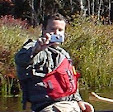 |
| What you need |
When you bake a cake in the oven (or Dutch oven), dry heat surrounds the cake. The water contained in the batter evaporates, creating steam that helps the cake rise before it sets and gets firmer. While steam does play a role in baking in dry heat, the results are much different when it acts as the main cooking method.
 |
| Covered cake pan on the rack |
Even at a lower temperature, though, steam will cook the cake faster than dry heat since it transfers heat more efficiently than air. Steaming a cake will take between 20 and 25 minutes, while dry baking it at 350 degrees will take 30 to 40 minutes.
 |
| Closed up for baking - the frying pan on the top is just there for weight |
- Stove with the ability to hold a pan of water at a low boil. If you are careful, you could do it on the fire, but maintaining the proper temperature might be tough.
- Set of nesting pans - the larger must have a tight fitting cover.
- A rack to raise the inner pan out of the water like a double boiler. In camp you could improvise - couple of small rocks would work fine.
- Cooking spray.
- Wax paper to line the bottom of the cake pan
- Aluminum foil to cover the inner pan
 |
| The finished corn bread in the pan |
- Fire up your stove
- Place the rack in the large pan and add enough water so that it is just below the rack. Cover, put the pan on the stove, and bring the water to a boil.
- While waiting for the water to boil, mix up the batter for whatever it is that you want to bake. Spray the inside of the smaller pan with cooking spray and add the batter. (Lining the bottom with wax paper will help the cake release easier from the pan when cooked.) Cover the top tightly with aluminum foil to prevent water from condensing onto the food and making it soggy.
- Once the water boils, reduce to a low boil and put the smaller pan on the rack inside the larger pan. Replace the cover and don’t remove for 20 to 25 minutes. You want just enough steam in the pan to cook the cake.
 |
| The finished corn bread removed |
I'd definitely call this experiment a success. The key is to cover the inner pan with foil to prevent condensed water from dripping on to the cake and making it rubbery. These pictures are Jiffy Mix cornbread, which came out perfect - just add chili for a great dinner.



No comments:
Post a Comment
Note: Only a member of this blog may post a comment.